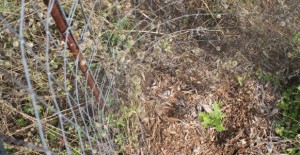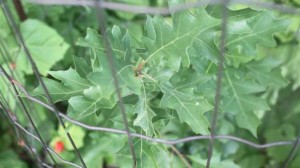A Travis County Audubon Society Project
Funded by Audubon Foundation of Texas
This grant funded the fencing and caging of oaks at the Travis Audubon Society’s Baker and Chaetura Canyon Sanctuaries to prevent the overgrazing of the abundant white-tailed deer on desired young oak species. In Baker Sanctuary the effort was to document and cage desired young oak species, particularly Spanish and shin oak. This will provide baseline data with regard to growth rates and micro-habitat characteristics. Fencing the remaining parts of Chaetura Canyon means that the Sanctuary is able to completely eliminate deer browsing, and Travis Audubon can now restore the habitat.
Travis Audubon’s mission is to promote the enjoyment, understanding, and conservation of native birds and their habitats. We work toward this through land conservation, habitat restoration and management, environmental education and conservation advocacy. Our three sanctuaries provide essential platforms for education and conservation. Ongoing funds are needed for maintenance and repairs of these special preserves. This funding addressed the need at two of our sanctuaries for caging/fencing to curb the browsing of the white-tailed deer population, which destroys native plants which provide habitat for many other species.
Baker Sanctuary is a 690-acre wildlife sanctuary in Leander that is dedicated to protecting the endangered Golden-cheeked Warbler (GCWA) and is part of the Balcones Canyonlands Preserve System. Travis Audubon holds youth nature camps and afterschool natural science educations at Baker. The terrain is dominated by the mature oak-juniper woodland that the GCWAs require to thrive and reproduce. GCWAs need habitat whose canopy layer is composed of Ashe juniper mixed with a variety of oak species such as plateau live oak, Spanish oak, and shin oak. Oaks are an important substrate where the Golden-cheeked Warbler forage for their arthropod prey, especially early in the breeding season. While the Ashe juniper population is flourishing, the oak population is struggling for a variety of reasons, including over-browsing by white-tailed deer, severe drought, and fungal pathogens.
Chaetura Canyon Sanctuary is located on the eastern edge of the Edwards Plateau and drains into the Colorado River just below Mansfield Dam. Comprised of 15 acres, it is home to more than 30 nesting avian species. With the exception of the lower canyon, most this preserve is now surrounded by high fence to exclude white-tailed deer and reduce the browse pressure on forbs and increase plant diversity. However, there are still two areas that need to be fenced to maximize habitat restoration goals and curtail the destructive browsing of deer. It is estimated that one deer eats approximately four pounds of vegetation per day, preventing the regeneration of hardwoods and under story plants.
At Baker Santuary in a three month period, from June through August 2014, twenty Spanish Oak (Quercus texana), fourteen Plateau Live Oak (Quercus fusiformis), thirteen Shin Oak (Quercus sinuata), and one Post Oak (Quercus stellata) were caged for a total of fifty-seven protected individuals. Data collected for each caged seedling included number of leaves, mid-stem diameter, seedling height, distance to nearest mature individual of the same species, number of oak seedlings within a 1 meter radius (all species), percent canopy cover, aspect (if applicable), and habitat type. The oaks were located and caged in an approximately 65-acre area centered around Baker Spring on the south side of Baker Sanctuary.
At Baker, our goal was to protect at least 30 oak seedlings from browsing by whitetail deer and that has been accomplished with the caging effort. An additional aspect of the project was the collection of baseline data regarding the morphological characteristics of the caged oaks as well as micro-habitat data which may influence survivorship and growth patterns. This aspect of the study will be long-term with additional data collected over the following years.
In Chaetura Canyon fencing was installed across the northern part of the property and connected to existing fencing. This has completely eliminate deer browsing, and we have begun to restore the habitat to its natural state. One of the newly-fenced parcels will be used as a model outdoor classroom for habitat restoration and trail-building techniques.

